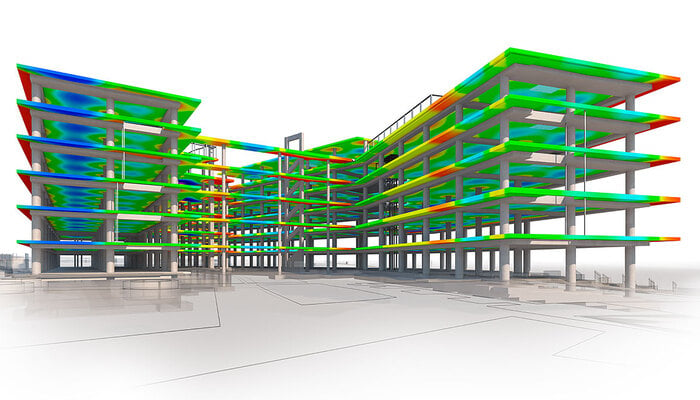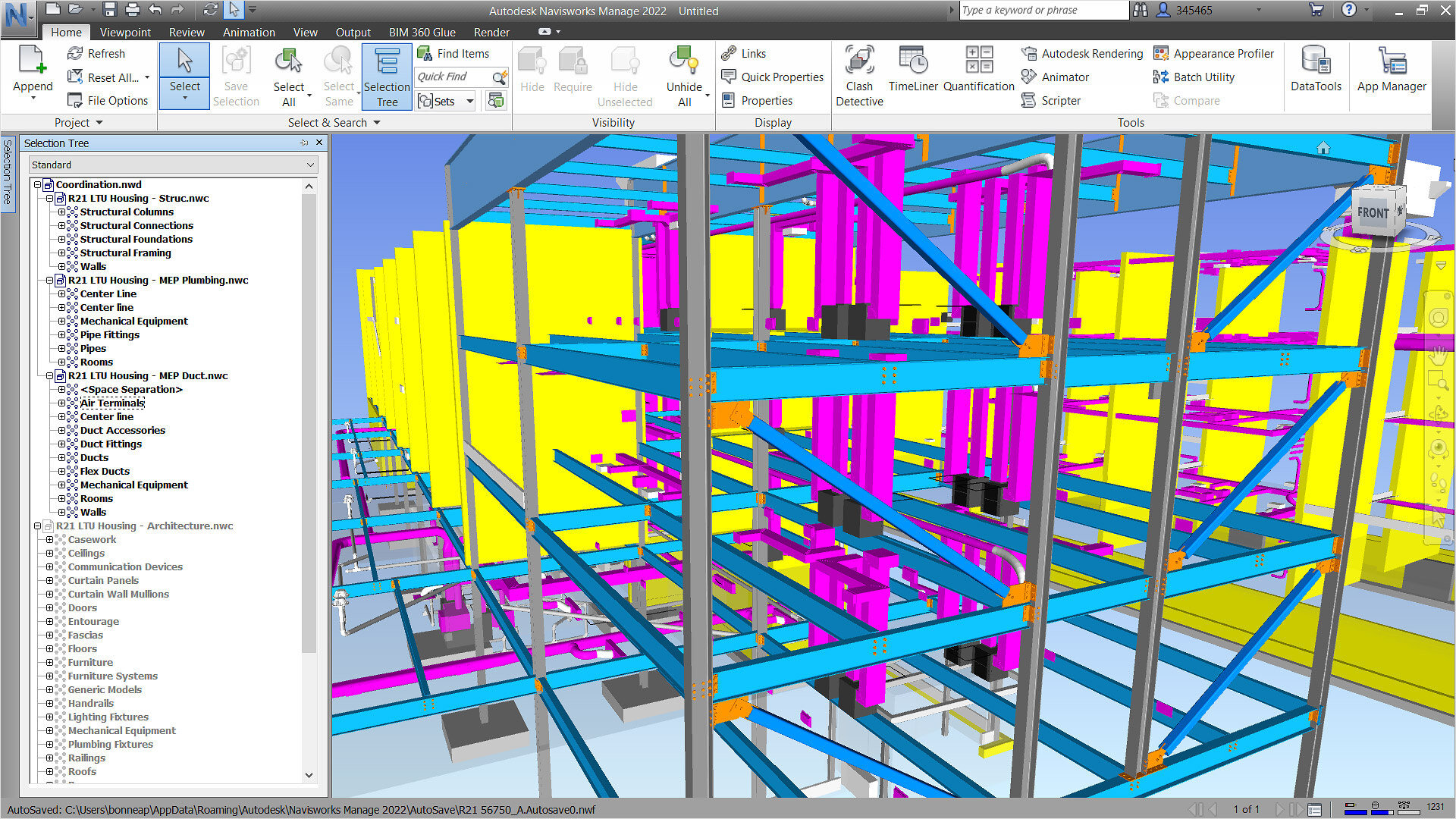Why is it Important for Civil Engineers to Learn BIM With CAD & CAE?

Table of Contents
Civil engineering is a field of work that brings visions to life. It transforms building designs from paper to reality, making them both tangible and functional. Therefore, the job of a civil engineer is demanding and requires utmost attention to detail and excellent analytical skills alongside good supervision and execution abilities. Traditionally, the role was considered very labour-intensive but with the advent of new technologies, civil engineering is transitioning into a tech-first industry.
Which Technologies are Reshaping the Design and Build Process in Civil Engineering?

Computation-driven technologies are at the forefront of the transformation that is presently happening in the Architecture, Engineering, and Construction (AEC) industry. These promising new-age technologies include Computer-Aided Design (CAD), Computer-Aided Engineering (CAE), Building Information Modelling (BIM), 3D printing, and robotics.
1. Computer-Aided Design (CAD)
Primarily used by design professionals such as architects and interior designers, CAD includes software tools that help in design concept visualisation and drafting structures. AutoCAD is the most commonly used designing software worldwide.
Also Read: How To Transition From CAD Drafter To BIM Technician
2. Computer-Aided Engineering (CAE)
Fundamentally used by civil and structural engineers, CAE refers to applying computer-aided mathematical analysis and simulation techniques in the product development process. Solidworks is a well-reputed CAE software in the construction industry.
3. Building Information Modelling (BIM)
BIM in civil engineering is a process of developing comprehensive multi-dimensional models that provide complete information about a building’s architecture and engineering. It brings the best of CAD and CAE together, serving as a unified platform for professionals to design, iterate, analyse, and build structures. Revit is one of the most popular BIM software in the AEC domain.
Also Read - Transition Guide To Switch From CAD To BIM Modeling
What is BIM in Civil Engineering?
BIM is a digital representation of the physical and functional assets of a structure. Contrary to traditional 2D drafting methods, BIM integrates various dimensions of information into a single coherent model, fostering collaboration and coordination among stakeholders throughout the project lifecycle. For civil engineers, BIM not only provides information about structural elements but also about the intricate network of utilities, landscaping, and other site-specific elements. It helps gain access to a comprehensive project overview, aiding the process of analysis and decision-making.
5 Advantages of BIM in Civil Engineering
BIM is a comprehensive solution that helps streamline the design and construction processes. It has emerged as one of the most sought-after technologies due to its ability to consolidate large amounts of information in a structured format. Let’s have a look at how this attribute has further enhanced the day-to-day operations and overall quality of work for construction professionals.
1. Enhanced Collaboration
BIM serves as a digital hub where architects, engineers, contractors, and stakeholders converge to collaborate seamlessly. It fosters real-time communication by centralising project data in a shared environment. This helps reduce errors, conflicts, and delays in the project.
2. Improved Decision-Making
Using BIM empowers civil engineers with comprehensive insights into project data, enabling informed decision-making at every stage. Through the generation of accurate simulations and analysis, professionals can compare design alternatives, assess overall building performance, and mitigate construction risks.
3. Clash Detection and Coordination
BIM software helps civil engineers visualise their designs in a virtual environment. This facilitates iterative refinement and ensures precision before the on-site execution begins. This efficiency accelerates project timelines and minimises costly redesigns and rework.
4. Quantification and Cost Estimation
BIM facilitates precise quantity takeoff of materials and resources, enabling engineers to generate detailed cost estimates. By linking design elements to cost data, BIM allows all project stakeholders to make informed budgetary decisions, minimising cost overruns and maximising return on investment.
5. Sustainability and Lifecycle Management
BIM equips engineers with tools to assess design impact on the environment and identify opportunities for energy efficiency and resource optimisation. BIM facilitates lifecycle management by enabling asset tracking, maintenance scheduling, and renovation planning, ensuring the long-term sustainability of built infrastructure.
5 Applications of BIM in Civil Engineering

The use of BIM in civil engineering is growing beyond leaps and bounds. It is anticipated that the global BIM market is expected to reach USD 23,950 million by 2027. Such an ambitious projection reflects the potential of BIM technology for projects of international significance. So, let’s explore the fundamental applications of BIM for civil engineers.
1. Streamlined Project Planning
BIM enables project stakeholders in project visualisation and design optimisation for cost-effectiveness and efficiency. By simulating various scenarios, civil engineers can anticipate challenges and devise effective strategies to mitigate them, thus streamlining the project planning phase.
2. Effective Communication
Civil Engineers, architects, and contractors can work together on a centralised BIM platform, sharing real-time updates, revisions, and feedback. This level of collaboration fosters better communication, reduces errors, and ensures that everyone is working towards a common goal, ultimately leading to smoother project execution.
3. Conflict Resolution
BIM allows engineers to identify potential clashes or conflicts early in the design phase. This includes clashes between structural elements, mechanical systems, and electrical components. By detecting and resolving these conflicts before construction begins, BIM helps mitigate risks, minimise rework, and prevent costly delays during the execution phase.
4. Sustainable Design
BIM supports environmentally friendly design practices by providing tools for energy analysis, daylighting simulations, and lifecycle assessment. Engineers can evaluate the environmental performance of different design options, optimise energy efficiency, and minimise the project's carbon footprint. Additionally, BIM facilitates the integration of renewable energy systems, green building materials, and other sustainable features into the design, promoting environmentally responsible infrastructure development.
5. Construction Management and Sequencing
Contractors can use BIM to create detailed construction schedules, visualise the construction process, and coordinate the activities of different subcontractors. They can simulate construction sequences to identify potential bottlenecks or logistical challenges in the project. This can help optimise resource allocation, improve workflow efficiency, and ensure on-time project delivery.
6. Asset Management and Maintenance
Civil engineers can leverage BIM to document as-built conditions, track equipment installations, and schedule preventive maintenance tasks. By accessing real-time data and 3D visualisations of building components, facility managers can make informed decisions, optimise maintenance workflows, and prolong the lifespan of infrastructure assets.
5 Popular BIM Software Used by Civil Engineers

BIM is a software-powered process. It involves the integration of computational algorithms and tools to be able to deliver the desired output. Let’s delve into the most popular and useful BIM software used by professionals across the globe.
1. Autodesk Revit
Revit is known for its robust abilities in 3D modelling, visualisation, and documentation. Designed specifically for building design and construction activities, Revit streamlines the entire project lifecycle, enabling seamless collaboration and coordination among multidisciplinary teams.
2. MicroStation
Bentley MicroStation is a BIM software liked by civil engineers for its versatility and interoperability. With a focus on infrastructure projects, MicroStation provides advanced tools for modelling, presentation, and analysis of architectural designs. The software seamlessly integrates with other software solutions, facilitating interoperability and data exchange across projects.
3. Tekla Structures
Tekla Structures is renowned for its expertise in structural engineering and construction. Tailored to the needs of civil engineers, Tekla Structures offers advanced modelling capabilities for steel, concrete, and timber structures, as well as comprehensive tools for detailing, fabrication, and project management.
Also Read - How To Use Tekla For Bridge Modeling
4. ArchiCAD
ArchiCAD is a versatile BIM software platform widely embraced by civil engineers for its intuitive interface and powerful design tools. It offers seamless integration of 2D and 3D modelling, as well as advanced visualisation and rendering capabilities. The software also facilitates collaboration with stakeholders throughout the project lifecycle.
5. Civil 3D
AutoCAD Civil 3D is a premium BIM software that offers comprehensive tools for the design, analysis, and documentation of roads, highways, and land development projects. With its dynamic modelling capabilities and integrated workflows, Civil 3D streamlines the entire design process, enabling engineers to optimise designs for efficiency, safety, and sustainability. Check out civil 3d courses to learn this in-demand software and ace in your engineering career.
Also Read: What is BIM for Civil & Structural Engineers, and How Do They Benefit From It?
3 Top Online BIM Courses Civil Engineers Can Pursue in 2025
BIM is being used by leading architecture and construction companies worldwide for a varying scale of projects. Construction firms like AECOM, Atkins, Larsen and Toubro (L&T), and Tata Consulting Engineers are hiring professionals with niche BIM skills. So, if you are someone who wants to work on international projects alongside who’s who of the industry, learning BIM is a must.
This can either be done offline through conventional classroom programs at universities or through future-relevant online courses offered on leading ed-tech platforms like Novatr, Udemy, and Coursera. Typically digital courses offer better value-for-money, practice-based learning, and schedule flexibility. Mentioned below are the most rewarding online BIM courses for civil engineers that they can explore to upskill themselves.
1. BIM Professional Course for Civil Engineers by Novatr 
Mode of learning: Online
Duration: 7 months
Certification: Yes
Placement Assistance: Yes
Fee: INR 1,95,000
This is one of the most holistic courses for civil engineers to learn BIM online. Students get insights into 10+ BIM software and their workflows including Revit, Civil 3D, and STAAD Pro. The course has flexible curriculum features and provides an engaging mix of live classes, mentorship sessions, and a capstone project. It covers topics like parametric modelling, generating and analysing reports, documentation, and presentation of BIM models. The self-paced nature of the course allows participants to learn in their own space and time, encouraging outcome-based learning as against traditional time-based learning.
2. BIM-Ready (Arch + Structure) by Techno Struct Academy
Mode of learning: Online
Duration: Three-and-a-half months
Fee: N/A
This course offered by Techno Struct Academy caters specifically to civil engineering professionals aiming to specialise in architectural and structural aspects within the BIM field. It is a comprehensive program extensively covering BIM tools, methodologies, and workflows that are tailored to architectural and structural design requirements. More so, learners can gain hands-on experience in using BIM tools for various architectural and structural design tasks. These practical skills enable civil engineers to effectively utilise BIM for precise structural analysis, optimisation of designs, and seamless collaboration with all project stakeholders.
3. BIM in AEC Industry Using Revit by Skill Lync
Mode of learning: Online
Duration: 3 months
This BIM course is well-structured with industry-relevant knowledge to equip learners with the necessary knowledge to succeed in their careers. Led by industry professionals, this online program delivers both theoretical knowledge and practical insights offering an insight into real-world projects through case studies and assignments. During the program, participants explore BIM principles and modelling tools by using software like Revit, Dynamo, and BIM 360. The curriculum imparts knowledge on the topics of modelling, documentation and layouts, structures, and Mechanical-Electrical-Plumbing (MEP) systems.
What’s Different About BIM Professional Course for Civil Engineers by Novatr?

BIM Professional Course for Civil Engineers by Novatr is a one-of-a-kind online program that offers comprehensive learning about the applications of BIM. The course is led by international industry experts. It is a cohort-based learning program allowing participants to interact with each other, making it a more engaging learning experience.
Students can apply their theoretical knowledge to a live RIBA-structured capstone project and test their skills. Taking the bar a notch higher, Novatr also provides placement assistance to all the course participants to help them secure their dream jobs in top-level AEC companies. All in all, the BIM Professional Course for Civil Engineers by Novatr can be a launchpad to having a successful career in the civil engineering field.
In Conclusion
BIM is booming. There is no second-guessing this statement. Therefore, civil engineers must learn BIM to build a future career. It is the stepping stone to exploring the next-gen of work in the construction and infrastructure segment that is more precise, detail-oriented, and agile. But, if you are still contemplating the idea of whether or not to upskill in BIM, here is a career transition success story that will compel you to make the shift.
Take your career to the next level by exploring the BIM Professional Course for Civil Engineers by Novatr today!
Also Read: Career Guide: Transition from Civil Engineer to BIM Modeller

 Thanks for connecting!
Thanks for connecting!




.png)





